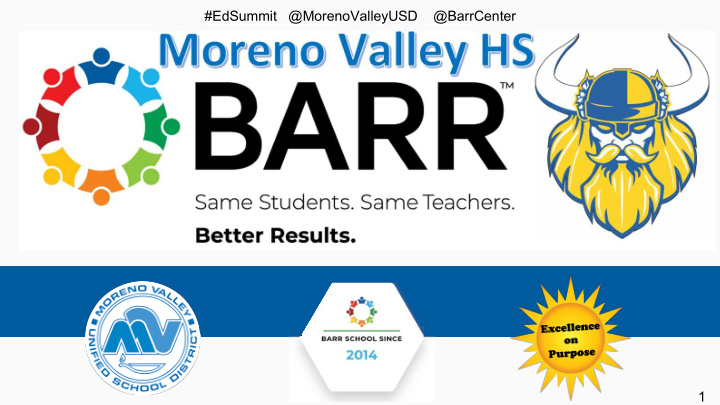



#EdSummit @MorenoValleyUSD @BarrCenter 1
Agenda 10:45 Agenda 10:45 - 11:30 am 11:30 am 10:45 - 10:50 am: Introductions 10:50 - 10:55 am: MVUSD Board President Susan Smith 10:55 - 11:00 am: MVUSD Superintendent Dr. Martinrex Kedziora 11:00 - 11:05 am: Rationale/Basis of the Model 11:05 - 11:15 am: Description of the Model & Data 11:15 - 11:23 am: Our Experience and Impact 11:23 - 11:30 am: Questions 2
Presenters Presenters Susan Smith Latoysha Brown Pedro Nuño Parwiz Ahmadi Dr. Martinrex Kedziora Board President Superintendent Principal Coordinator Science Teacher 3
MVUSD Goals MVUSD Goals Goal 1: All students proficient in literacy, numeracy, critical thinking and technology skills. Goal 2: All students graduate high school prepared to successfully enter into higher education and/or pursue a viable career path. Goal 3 : Learning environments support all students to thrive academically at the rigor of each grade level. 4
Established in 1998, Minneapolis, Minnesota 5
Rational/Basis of the Practice Rational/Basis of the Practice Why BARR? MVHS is located in Moreno Valley’s oldest neighborhood that is steeped in poverty. We have 2,349 students in grades 9-12. In terms of demographics: ● 91% of MVHS students are socioeconomically disadvantaged ● 96% are of diverse ethnicity ○ 80% Hispanic ○ 11% African-American ● 15% are English learners Food insecurity, mobility, gangs, drugs, and alcohol are prevalent issues in the community. 6
Rational/Basis of the Practice Rational/Basis of the Practice Exactly what we needed: MVHS was in need of solutions to engage students, support them in their social/ emotional needs, life needs, and academics so they can have access to a brighter future. School Strength: Relationships BARR took our strength as a school and gave us a system to better serve our students thus transforming the staff and students’ mindsets. BARR is a strengths based model that harnesses the power of relationships and data to shift the mindset and culture in a school. Same teachers. Same students. Better Results. 7
8
5. Hold regular meetings of the cohort 1. Focus on the whole student teacher teams 2. Provide professional development for 6. Conduct risk review meetings teachers, counselors & administrators 7. Engage families in student learning 3. Use BARR’s I-Time Curriculum to foster a climate for learning 8. Engage administrators 4. Create cohorts of students 9
Description of the Practice Description of the Practice 5. 6. 10
Description of the Practice Description of the Practice #1 Focus on the whole student 11
Description of the Practice Description of the Practice 7. Engage families in student learning: BARR improves communication with families and makes them active partners. Teachers and staff call and meet consistently with parents and try to get them involved in their student’s education, so together we can help the students succeed. 12
Results of the Practice Results of the Practice The BARR model has been proven to create statistically significant impacts in 19 areas of academic performance and outcomes for students, teachers, and schools, including especially powerful results narrowing opportunity gaps for students of color and students from low- income families. 13
Results of the Practice Results of the Practice Outcomes of BARR at MVHS are an increase in: ● Passing rates ● Credits earned ● Student GPAs ● Attendance rates ● Improved learning environment which decreases suspension rates 14
Results of the Practice Results of the Practice HALF BARR Data by School Year Full BARR Full BARR FULL BARR BARR NO BARR NO BARR NO BARR NO BARR NO BARR 2017-2018 2016-2017 2015-2016 2014-2015 2013-2014 2012-2013 2011-2012 2010-2011 2009-2010 School Year A 1928 2238 2134 1904 1761 1602 1337 1605 1553 B 1600 1593 1694 1459 1524 1463 1414 1571 1545 C 1366 1336 1609 1339 1463 1509 1500 1617 1563 D 944 923 1037 1077 1058 1136 1182 1346 1220 F 1443 1336 1305 1550 1644 1915 1848 2151 2290 19.82% 17.99% 16.78% 21.15% 22.07% 25.11% 25.38% 25.95% 28.03% % of Fs 2.22 2.33 2.30 2.15 2.09 1.96 1.89 1.90 1.86 Avg. GPA 47.27% 45.58% 42.58% 49.72% 48.83% 57.18% 58.48% 57.87% 64.19% % of students with at least one F 80.18% 82.01% 83.22% 78.85% 77.93% 74.89% 74.62% 74.05% 71.97% Percent of Credits Earned 15
Results of the Practice Results of the Practice Total # of # of Students # of days 9th grade School Year Suspensions Suspended suspended 238 155 810 No BARR 2010-2011 149 102 507 No BARR 2011-2012 173 103 563 No BARR 2012-2013 163 85 471 No BARR 2013-2014 72 41 206 Half BARR 2014-2015 60 43 176 Full BARR 2015-2016 87 63 296 Full BARR 2016-2017 102 74 322 Full BARR 2017-2018 16
Results of the Practice Results of the Practice School BARR Data 4 year average NO BARR BARR 4 Yr. Avg. # of Years days suspended School Year 2010-2014 2014-2018 2010-2014 587.75 (No BARR) Failure Rate 26.12% 18.20% 2014-2018 Average GPA 1.90 2.28 250 (BARR) % of students w/ @ least one F 59.43% 45.14% Percent of Credits Earned 73.88% 81.80% 17
Results of the Practice Results of the Practice BARR Closes the Gap in Graduation Rates NO NO NO NO NO NO NO NO Half MVHS BARR BARR BARR BARR BARR BARR BARR BARR BARR School 2009 - 2010 - 2011 - 2012 - 2013 - 2014 - 2015 - 2016 - 2017 - Year 2010 2011 2012 2013 2014 2015 2016 2017 2018 Graduatio n Rate 68.3% 68.4% 73.1% 79% 83.4% 89.7% 88% 87.5% *90+% *Anticipated Graduation Rate 18
District Data District Data Three High Schools are implementing BARR 2014 2015 2016 19
Our Experience and Impact Our Experience and Impact 20
Questions Questions Become a BARR School Visit ww.barrcenter.org 21
Recommend
More recommend